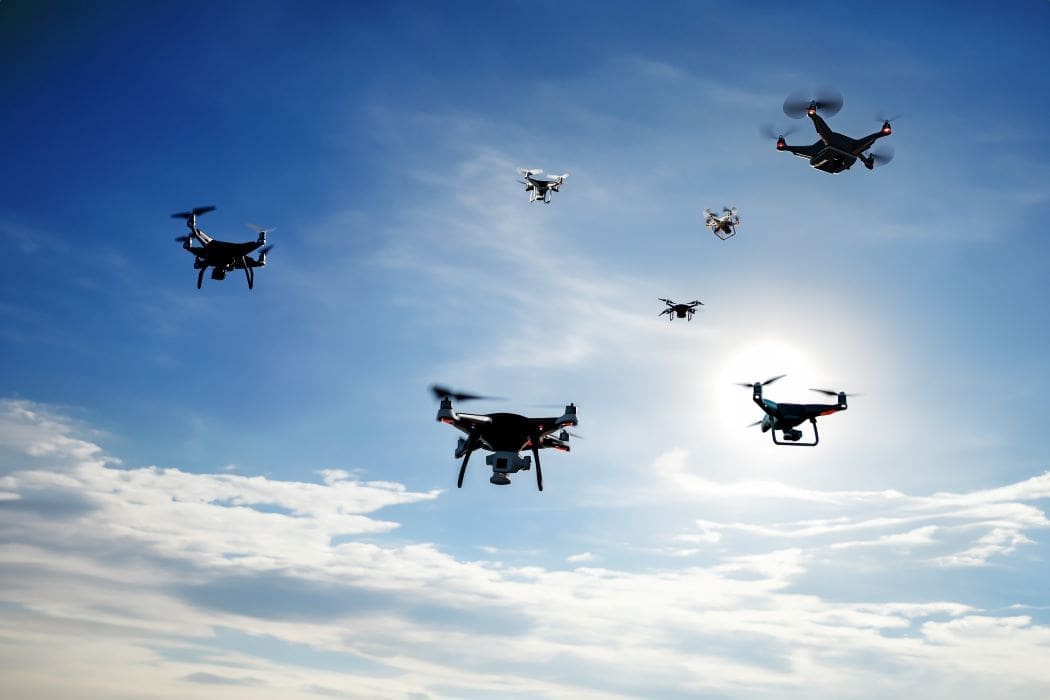Drone swarms are becoming increasingly popular as tools to support military activities, but there are key considerations that must be made before they become too prolific to contain.
Over the past few years, there’s been an exponential increase in the use cases and innovations of unmanned aerial vehicles (UAVs). Prior to 2014, China, the UK, Israel, and the USA were the only countries with armed drone programs in place, specifically MALE drones, but by 2023, the number had increased from just four to 37. The influence of drones has scaled significantly, and so have the variations in the type of drone and their capabilities.
The Modern War Institute believes that this move towards drones is mainly being driven by the third age of drone warfare, one that leverages autonomous devices, saturation attacks, and ‘increased precision and range across land, sea and air’. There is little doubt that drones will remain a priority investment for countries – their ubiquity is hard to beat – but how they are used and in what quantities will depend entirely on the state, the budget, and the challenges faced.
As drones become more powerful and accessible, it becomes increasingly important to unpack the challenges that drone swarms introduce and the need for strong controls to protect citizens and countries. On the other hand, it’s interesting to see how drones are evolving—and how rapidly—to meet the changing demands of the industry.
Plug and fly: the future of the swarm
It’s hard to imagine that a swarm of 20 or more drones could be controlled by an out-of-the-box solution, yet this is precisely what companies like Geoscan and Red Cat Holdings are already doing. Geoscan offers a drone swarm starter kit with basic capabilities, while Red Cat delivers six UAS to your front door, all ready to take off and undertake surveys and photography. While these are more suited to the commercial side of drone swarm use cases, they’re an example of the technology’s adaptability and the value it can provide to the military.
Interestingly, the use of these kits could also be extended to the management and maintenance of large drone swarms, reducing the military’s high cost of ownership. If teams can swap out parts or manage maintenance with ease, then it would also reduce downtime in the field.
In a recent paper on drone swarm strategy, researchers found that a swarm of drones can achieve tasks that are impossible for solo drones. Another paper in Science Direct echoed this ubiquity, emphasizing how autonomous swarms can intelligently and reliably scan an area at improved speeds and with better results.
The autonomous capabilities of drones are changing the shape of use cases and innovation. The US Navy has recently used air and sea drone swarms to gather data and manage enemy fleet navigation. In a recent article, Defense One interviewed one of the commanders in charge of autonomous drone operations, who unpacked how both land and water drones collaborated and communicated with one another to provide a more holistic view of the environment and situation.
Solid advancements in autonomous drone technology are very likely over the next few years, allowing for better control and scale with less risk.

The implications of the swarm
Some countries will easily afford to invest in high-end drone swarms capable of providing air support, undertaking missions, or handling battle situations; others will not. Some will have the technology to defend against these swarms; others will not. The balance of power has always rested in the hands of those with the biggest toys, but drone swarms do put a little more weight on the one-sided scales and can introduce ethical risks that need to be addressed on a global regulatory scale. Should, for example, there be a limit on the size of the drone swarm army allocated to each country?
It’s also essential that there are discussions around the development and deployment of drones within regulatory and legal frameworks, particularly around international warfare laws and the protection of civilians.
The size and shape of the integrated swarm
Using the combined intelligence of the hive mentality, drone swarms have immense power. A large swarm can clear the way for manned missions, can be used to gather data, can undertake tactical maneuvers, and can provide long-range, armed support or defense. There are challenges, however:
When building a drone swarm, teams must consider the following:
- Drones can work harmoniously to prevent potential failure and mitigate risk to personnel and assets.
- The signals used to communicate with and control the swarm don’t interfere with other signals in the region or with one another.
- Available charge and the need to ensure drones can handle the amount of time they’re required to be in the air and to complete a mission.
- Hacking poses a serious threat as adversaries could gain control and disrupt operations, which makes cybersecurity a priority.
- Autonomous operations could lead to unintended consequences or ethical dilemmas in combat scenarios if there is a loss of human control.
In conclusion
There is little doubt that drone swarms offer immense potential to the military and bring with them their own unique challenges and considerations. As military institutions look to the future, they want drone swarm solutions that allow them to achieve their objectives while helping them overcome these challenges, and this is where Maris-Tech comes in.
Playing a pivotal role in supporting innovation, our cutting-edge AI and video streaming technologies provide intelligent solutions that enhance the real-time capabilities of drone swarms. Our technologies empower teams to create swarms capable of performing complex tasks reliably. We provide low-latency video encoding and decoding technologies so data is transmitted and received almost instantaneously – a crucial capability for drone swarms as it ensures the effective coordination and operation of the swarms in dynamic and often hostile environments.
One of Maris-Tech’s signature products, Jupiter Nano, is a compact and powerful system that integrates high-quality video streaming, superb energy efficiency, and AI-driven analytics in a miniature form factor that can be used in various military applications. The Jupiter Nano can transmit and process data in real-time so that military operations gain immediate situational awareness and decision-making capabilities. This improves mission precision and efficacy while mitigating some of the key challenges faced with drone swarm management and control.
All our innovations are further supported by our partnerships with leading defense organizations. We prioritize innovation with reliability built on a foundation of expertise and a commitment to value. We drive the advancements of drone swarm technology through partnerships, planning and perfectionism – and believe that the future of modern warfare lies in collaboration and innovation.
Learn more about remote video streaming, video analytics edge computing, and Maris Tech’s embedded ai systems.


